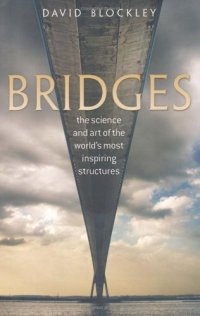
Ebook: Bridges: The science and art of the world's most inspiring structures
Author: David Blockley
- Genre: Technique // Construction
- Tags: Промышленное и гражданское строительство, Проектирование мостов тоннелей и труб
- Year: 2010
- Publisher: Oxford University Press
- Language: English
- pdf
This book is written by a professor of engineering, but with the general reader in mind. Although it deals with technical matters, these are presented in a way that does not require a high level of mathematics or physics. It has 50 illustrations including many magnificent photographs.
The structure of the book is as clear as the structure of the bridges that it discusses. After an introductory chapter it considers the four main types of bridge in turn; beams, arches, trusses, and suspension. It then considers the question of safety, and finally the development and maintenance of bridges as team work.
Bridges are considered as works of art as well as civil engineering, and the book is very rich in references to other arts and to culture in the widest sense, with references to Newton, Kant, Michelangelo, Giotto, Palladio, Herodotus, Tracey Emin, Antony Gormley, and many others. David Blockley also considers bridges as symbols, icons, landmarks, and as objects of inspiration.
There are fascinating sections on many celebrated bridges including the wobbly Millennium Bridge, the Clifton Suspension Bridge, the Salginatobel Bridge, and the Millau Viaduct.
This is also a book that could be of value to schools. It brings maths and physics to life, and could be a vehicle for taking students on trips to visit bridges to see how these disciplines are used in practice in ways that are important as transport links as well as being imaginative and inspirational.
This book is written by a professor of engineering, but with the general reader in mind. Although it deals with technical matters, these are presented in a way that does not require a high level of mathematics or physics. It has 50 illustrations including many magnificent photographs. The structure of the book is as clear as the structure of the bridges that it discusses. After an introductory chapter it considers the four main types of bridge in turn; beams, arches, trusses, and suspension. It then considers the question of safety, and finally the development and maintenance of bridges as team work. Bridges are considered as works of art as well as civil engineering, and the book is very rich in references to other arts and to culture in the widest sense, with references to Newton, Kant, Michelangelo, Giotto, Palladio, Herodotus, Tracey Emin, Antony Gormley, and many others. David Blockley also considers bridges as symbols, icons, landmarks, and as objects of inspiration. There are fascinating sections on many celebrated bridges including the wobbly Millennium Bridge, the Clifton Suspension Bridge, the Salginatobel Bridge, and the Millau Viaduct. This is also a book that could be of value to schools. It brings maths and physics to life, and could be a vehicle for taking students on trips to visit bridges to see how these disciplines are used in practice in ways that are important as transport links as well as being imaginative and inspirational.
This book is written by a professor of engineering, but with the general reader in mind. Although it deals with technical matters, these are presented in a way that does not require a high level of mathematics or physics. It has 50 illustrations including many magnificent photographs. The structure of the book is as clear as the structure of the bridges that it discusses. After an introductory chapter it considers the four main types of bridge in turn; beams, arches, trusses, and suspension. It then considers the question of safety, and finally the development and maintenance of bridges as team work. Bridges are considered as works of art as well as civil engineering, and the book is very rich in references to other arts and to culture in the widest sense, with references to Newton, Kant, Michelangelo, Giotto, Palladio, Herodotus, Tracey Emin, Antony Gormley, and many others. David Blockley also considers bridges as symbols, icons, landmarks, and as objects of inspiration. There are fascinating sections on many celebrated bridges including the wobbly Millennium Bridge, the Clifton Suspension Bridge, the Salginatobel Bridge, and the Millau Viaduct. This is also a book that could be of value to schools. It brings maths and physics to life, and could be a vehicle for taking students on trips to visit bridges to see how these disciplines are used in practice in ways that are important as transport links as well as being imaginative and inspirational.
Download the book Bridges: The science and art of the world's most inspiring structures for free or read online
Continue reading on any device:

Last viewed books
Related books
{related-news}
Comments (0)